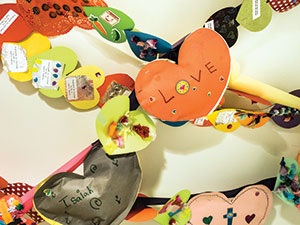Art from Bible stories adorns the walls of historical country churches in Sweden. A tour guide gives their history and explains that the artwork does more than beautify the space — the pictures once reinforced the Bible stories for illiterate members. Worshipers who couldn’t read Scripture were reminded of them each time they sat in the sanctuary.
This emphasis on space — on surroundings and design — can also be used to update our older church buildings and plan new ones in a way that welcomes children and families.

Rick Riddle
If we only pay attention to how ministry activities extend hospitality and support learning, we’re missing the chance to use physical space to do the same. Every church space conveys a theological point of view about our welcome and value of children — in planned and unplanned ways.
Following are several observations and strategies to help congregations create and improve child-friendly spaces. Here’s the good news: none of these takes a lot of money or big changes. But they do require using a different lens to deliberately look at space and some creativity to make tweaks and adjustments.
Find (and fix) invisible spaces
Most of us stop noticing things in our home that need repair or an upgrade — a dripping faucet, a clock that needs new batteries or outdated towels that should be banished to the pet bed.
When we become too familiar with a space, we stop tuning into what a newcomer would notice. The same can be true of church space designated for children — chewed board books on the library table or dingy changing tables in the nursery. Often the narthex offers little indication that children are part of the community.
When our church space becomes so lived in that we stop noticing what might be a clear signal to a visiting family, it’s time to make adjustments.
Try this: Do a quick audit of any potentially invisible spaces. Divide a piece of paper into four squares and write each of these words in each space: functions, features, flaws, fixes.
Then watch on a Sunday (or midweek) how the space is used. Record what you notice about how the space functions, the physical features you notice, evident flaws and ideas for fixing the space to better serve those using it.

Rick Riddle
Unlock the space’s meaning
Church buildings are filled with furnishings, artwork and architecture that convey Bible stories, theological concepts and rich church traditions. But here’s the problem: these meanings are often hidden from kids unless we show and tell about them multiple times.
A pulpit’s carvings, the stained-glass windows, the cruciform shape of the sanctuary — all are visual features that can be appreciated by even the youngest of children. Pointing them out enables kids to see how our Christian beliefs are embedded in our church surroundings. We help kids understand why our buildings look the way they do (plus, kids love learning about the secret meanings of things).
Try this: Walk through your church taking an inventory of the artwork. How could you help kids notice and understand the significance of these pieces? Use a children’s sermon to focus on the artwork, or ask someone to make a photo book that has pictures and explanations of it.

Rick Riddle
Steal from the best
Your community has spaces that are already child-friendly. Recall the furnishings and layout of McDonald’s, for instance — bright colors, play spaces and Happy Meal toys displayed at eye level.
Or how about the family friendly features of Ikea stores — parking spots reserved for families with young children, kid-friendly menus and restaurant seating, and free child care that allows parents to shop uninterrupted?
Notice your library’s children’s section with books in easy-to-reach displays and comfy reading chairs.
Try this: Visit a child-friendly spot in your community and observe the ways that space is inviting for children. Seating, signage, artwork and color palette all beckon to the child: “Make yourself at home. Stick around. You’re welcome here.” Strive to have your church’s space offer the same kind of feel, but with a deeper, life-changing message about welcome and belonging.
7 things you can do now
- Place a kid-size table and chairs in your fellowship hall. Make sure there are also high chairs.
- Reinforce the importance of fathers caring for their little ones by putting changing tables in the men’s room(s).
- Place bathroom signs with symbols and words at children’s eye level. If that means two signs on each door, that’s OK.
- Reposition some of the church’s artwork to a child’s eye level.
- Make sure signage at all entrances let families know exactly where their child should go when they arrive.
- Liven up hallway walls by displaying kids’ artwork (not just in the Sunday school area).
- Include faith-based messages, music and images in the nursery so they convey that this is a place of faith, not just baby-sitting.




